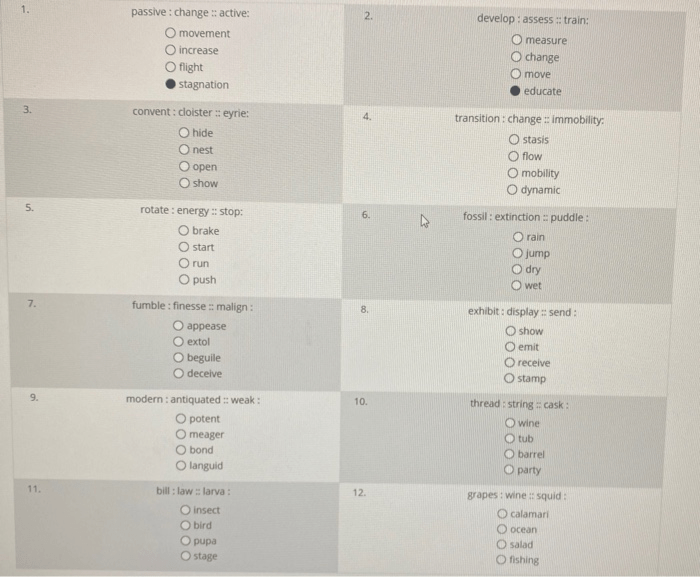Develop : assess :: train: – this trio of terms forms the cornerstone of effective skill enhancement. In the realm of education and training, understanding the nuances between these concepts is paramount to unlocking the full potential of learners.
Development, the process of acquiring new knowledge and skills, provides the foundation upon which assessment can build. Assessment, in turn, serves as a valuable tool for measuring progress, identifying areas for improvement, and guiding further development.
Meaning and Definitions
In the context of education and training, “develop” and “assess” are two distinct terms with specific meanings and applications.
Develop
The term “develop” refers to the process of fostering or promoting the growth, skills, or abilities of an individual or group. It involves providing opportunities for learning, practice, and feedback to enhance knowledge, skills, and capabilities.
- Examples of developing include designing and implementing training programs, providing on-the-job training, and offering professional development opportunities.
Assess
In contrast, “assess” refers to the process of evaluating or measuring the performance, progress, or outcomes of an individual or group. It involves gathering information to make judgments about the effectiveness of training programs or the attainment of learning objectives.
- Examples of assessing include conducting tests, evaluating projects, and observing performance on the job.
Purposes and Goals

The development and assessment of skills and knowledge serve distinct yet complementary purposes. Understanding these purposes helps us appreciate the importance of both processes in education and professional growth.
Just like how you assess the effectiveness of training, you can also assess the development of your skills. For instance, Los Pinero de Nueva York are renowned for their artistry and cultural impact. Their development as artists can be assessed through their performances, exhibitions, and critical reception.
By evaluating the outcomes, you can determine the effectiveness of their development journey, akin to assessing training.
Development encompasses the acquisition and enhancement of skills and knowledge through learning and practice. It aims to improve competence and expand capabilities. Assessment, on the other hand, measures the extent to which individuals have achieved the desired learning outcomes. It provides feedback on progress, identifies areas for improvement, and serves as a basis for decision-making.
Objectives of Development
The objectives of development focus on:
- Enhancing skills and knowledge to meet specific goals or requirements.
- Facilitating the acquisition of new abilities and expertise.
- Promoting continuous learning and personal growth.
- Preparing individuals for future challenges and opportunities.
Objectives of Assessment
The objectives of assessment include:
- Evaluating the effectiveness of learning and development initiatives.
- Identifying strengths and weaknesses in skills and knowledge.
- Providing feedback to individuals on their progress and areas for improvement.
- Making decisions about further development and support needs.
Methods and Techniques
Developing skills and knowledge and assessing their effectiveness are crucial aspects of learning and development. Various methods and techniques can be employed to facilitate these processes, each with its own advantages and applications.
To develop skills and knowledge, common methods include:
- On-the-job training:Learning through hands-on experience in the workplace.
- Classroom training:Structured learning sessions led by an instructor or facilitator.
- E-learning:Online courses and resources that provide flexible and self-paced learning.
- Mentoring:Guidance and support from an experienced individual in the field.
- Apprenticeship:A structured program that combines on-the-job training with classroom instruction.
For assessing skills and knowledge, different strategies can be used:
- Observation:Direct observation of performance in a real-world setting.
- Testing:Formal assessments that measure knowledge and skills through exams or quizzes.
- Assessment centers:Simulations that evaluate candidates’ skills and abilities in a realistic work environment.
- Portfolio assessment:Collection of work samples that demonstrate a candidate’s skills and knowledge.
- 360-degree feedback:Evaluations from multiple sources, including supervisors, colleagues, and clients.
The following table provides a comparison of some of these methods and techniques:
| Method/Technique | Advantages | Disadvantages |
|---|---|---|
| On-the-job training | Practical experience, immediate feedback | May be unstructured, limited scope |
| Classroom training | Structured, comprehensive, interactive | Can be inflexible, less hands-on |
| E-learning | Flexible, self-paced, cost-effective | May lack social interaction, requires self-discipline |
| Observation | Real-time assessment, contextualized | Subjective, may be biased |
| Testing | Objective, quantifiable, standardized | May not measure all skills, potential for cheating |
Relationships and Connections

Development and assessment are two sides of the same coin. They are inextricably linked and mutually dependent. Development is the process of acquiring new knowledge, skills, and abilities. Assessment is the process of measuring and evaluating the progress of development.
Assessment can inform and guide development in several ways. First, assessment can help to identify areas where students need additional support. For example, if a student is struggling with reading comprehension, an assessment can help to identify the specific skills that the student needs to improve.
Second, assessment can help to motivate students to learn. When students know that they will be assessed, they are more likely to put in the effort to learn the material. Assessment can also help students to track their progress and see how they are improving.
Third, assessment can help to provide feedback to teachers. Assessment can help teachers to identify which teaching methods are most effective and which students need additional support.
Examples of Interconnectedness
- A student takes a math test and scores poorly. The teacher uses the test results to identify the areas where the student needs additional support.
- A teacher gives a writing assignment and provides feedback to the students on their work. The students use the feedback to improve their writing skills.
- A school district conducts an assessment of all third-grade students. The results of the assessment are used to identify the schools that need additional resources.
Challenges and Considerations: Develop : Assess :: Train:

Developing and assessing skills and knowledge present various challenges and considerations. These include identifying and addressing ethical implications, biases, and the impact of technology.
Ethical implications arise when assessments are used to make decisions about individuals, such as hiring or promotion. It is essential to ensure that assessments are fair and unbiased and do not discriminate against any particular group of people.
Ethical Implications and Biases in Assessment
- Potential for bias in assessment design, administration, and interpretation.
- Consequences of biased assessments on individuals and groups.
- Strategies to mitigate bias and promote fairness in assessment practices.
Impact of Technology on Development and Assessment
- Opportunities and challenges of using technology in skill development and assessment.
- Ethical considerations related to the use of technology in assessment.
- Implications of technology for the future of skill development and assessment.
Best Practices and Recommendations
Effective development and assessment practices are crucial for enhancing the quality and impact of learning experiences. Here are some best practices and recommendations to consider:
- Align development and assessment with learning objectives:Ensure that the development activities and assessment tasks directly address the intended learning outcomes.
- Use a variety of development and assessment methods:Engage learners with diverse learning styles by incorporating a range of activities, such as hands-on projects, simulations, and self-reflections.
- Provide timely and specific feedback:Offer constructive and actionable feedback that helps learners identify areas for improvement and supports their progress.
- Involve learners in the assessment process:Empower learners by giving them opportunities to self-assess and reflect on their learning, fostering ownership and accountability.
- Use technology to enhance development and assessment:Leverage technology tools to create interactive learning experiences, provide real-time feedback, and facilitate collaboration.
Examples and Case Studies

To illustrate the practical applications of development and assessment, let’s delve into real-world examples and analyze successful case studies.
Case Study: Employee Development and Assessment in a Tech Company, Develop : assess :: train:
A technology company implemented a comprehensive development and assessment program for its employees. The program focused on identifying high-potential individuals and providing them with tailored training and mentorship opportunities. Regular assessments were conducted to evaluate employee progress and adjust development plans accordingly.
This program resulted in increased employee engagement, improved performance, and reduced turnover.
Example: Assessment of Student Learning in a Virtual Classroom
In a virtual classroom, instructors employed online assessment tools to monitor student learning and provide timely feedback. Quizzes, discussion forums, and peer reviews were used to assess student understanding and critical thinking skills. The data gathered from these assessments informed instructional decisions, allowing instructors to adapt their teaching methods to meet the specific needs of the students.
FAQ Explained
What is the primary distinction between development and assessment?
Development focuses on acquiring new knowledge and skills, while assessment measures progress and identifies areas for improvement.
How can assessment inform development?
Assessment provides valuable feedback that can guide further development by highlighting strengths and weaknesses.
What are some common challenges in developing and assessing skills?
Challenges include identifying effective development methods, designing meaningful assessments, and addressing biases.